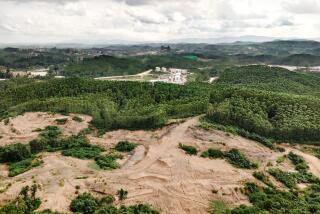Bucharest Undergoing Controversial Face Lift
BUCHAREST, Hungary — Ignoring protests from abroad, Romania’s communist leader Nicolae Ceausescu has demolished a large part of old Bucharest for a monumental civic center being built at breakneck speed.
In a project on a scale not seen since the reordering of central Paris under Napoleon III, Ceausescu has changed the face of a city once known as “the Paris of the Balkans.”
Thousands of houses reflecting a wide variety of styles and national influences--Wallachian, Transylvanian, Turkish and French--have been bulldozed since 1980 to make way for a city center hailed by Ceausescu as more appropriate for a modern communist society.
It includes the massive 17-story House of the Republic, which will house the Communist Party and the government, the 1.8-mile-long Boulevard of the Victory of Socialism, and the main ministries.
There will also be a congress hall seating 12,000 people, with a dome that will dwarf St. Peter’s in the Vatican, a national library, museum, opera house and cultural center, exhibition hall and theaters, as well as apartments for thousands of people.
As described by Romanian officials, the project is providing much-needed cultural and administrative facilities left out of earlier modernization schemes that concentrated on improving infrastructure and building new housing for an exploding population.
Stalin-Era Type Project
Critics, mainly from abroad, see it as a grandiose, Stalin-era type project promoted by Ceausescu and being rushed to completion in time to mark his 25 years in power in 1990.
Western diplomats noted that the mammoth scheme, employing tens of thousands of workers and huge resources, is being pushed ahead at a time when the Romanian people are suffering chronic food and power shortages for the fifth year running.
Western critics have also charged that many historic buildings, including 19 churches, a Sephardic synagogue and one of the largest monasteries in southeast Europe, were demolished to make way for the new center.
Chief Bucharest architect Constantin Jugurica denied that any valuable buildings had been destroyed, and noted that several churches had been moved, in a process developed in Romania, to other sites.
He said the churches destroyed were either of little historical or architectural interest, or had been badly damaged in the devastating 1977 earthquake.
Occupied by Foreigners
“Because of its geographical position, Bucharest was constantly being occupied and destroyed by other nations throughout its history,” he said in an interview. “Because of this uncertainty, people didn’t build houses very solidly.”
The claim that nothing valuable was destroyed is widely disputed.
In one of the few open criticisms voiced in Romania, where a large and efficient secret police force crushes all dissent, former Foreign Minister and Writers’ Union Chairman George Macovescu bemoaned the destruction of one of the city’s oldest inns in 1985.
“The Yellow Inn had its own history and legend, and did not deserve to perish under the bulldozers of the new times,” he wrote in the union’s almanac.
“For we ought not to flatten out with the bulldozer any trace of the past, the more so since the adversities of our history have already destroyed too much. The present and the future need the testimony of bygone years.”
Gorbachev’s Hope
Soviet leader Mikhail S. Gorbachev, when shown the new project during a visit to Bucharest last year, expressed the hope that historical architecture would be preserved, adding: “We failed to do this in some places in Moscow, and now we are regretting it.”
The destruction of the old center forced tens of thousands of people to give up their homes and move to drab modern apartment blocks in one of three new towns ringing the city.
According to Western diplomats, many of the former residents were given only 24 hours to pack up and vacate their homes before the bulldozers moved in. Many others were forced to sign statements saying they had moved voluntarily.
Jugurica said many people had welcomed the destruction of homes without running water and other conveniences. Others wanted to move because they feared another earthquake, he said.
Some critics of the scheme see the destruction of privately-owned homes in the old city as also fitting in with a “grand design” by Ceausescu to stamp out what he regards as remnants of bourgeois life and create a “new socialist man.”
Another Controversial Scheme
In the countryside, Ceausescu has launched another controversial scheme to drastically reduce the number of villages and relocate the inhabitants in apartment blocks in new towns.
“Planning as a means of social control is not new, but in Bucharest it can be seen at its most extreme,” leading British architecture critic Colin Amery wrote recently.
American conservationist Janet Heller, writing in the New York Times, said: “By turning owners into tenants, Mr. Ceausescu hopes to create a new citizen who thinks in collective terms according to socialist principles.”
More to Read
Sign up for Essential California
The most important California stories and recommendations in your inbox every morning.
You may occasionally receive promotional content from the Los Angeles Times.










